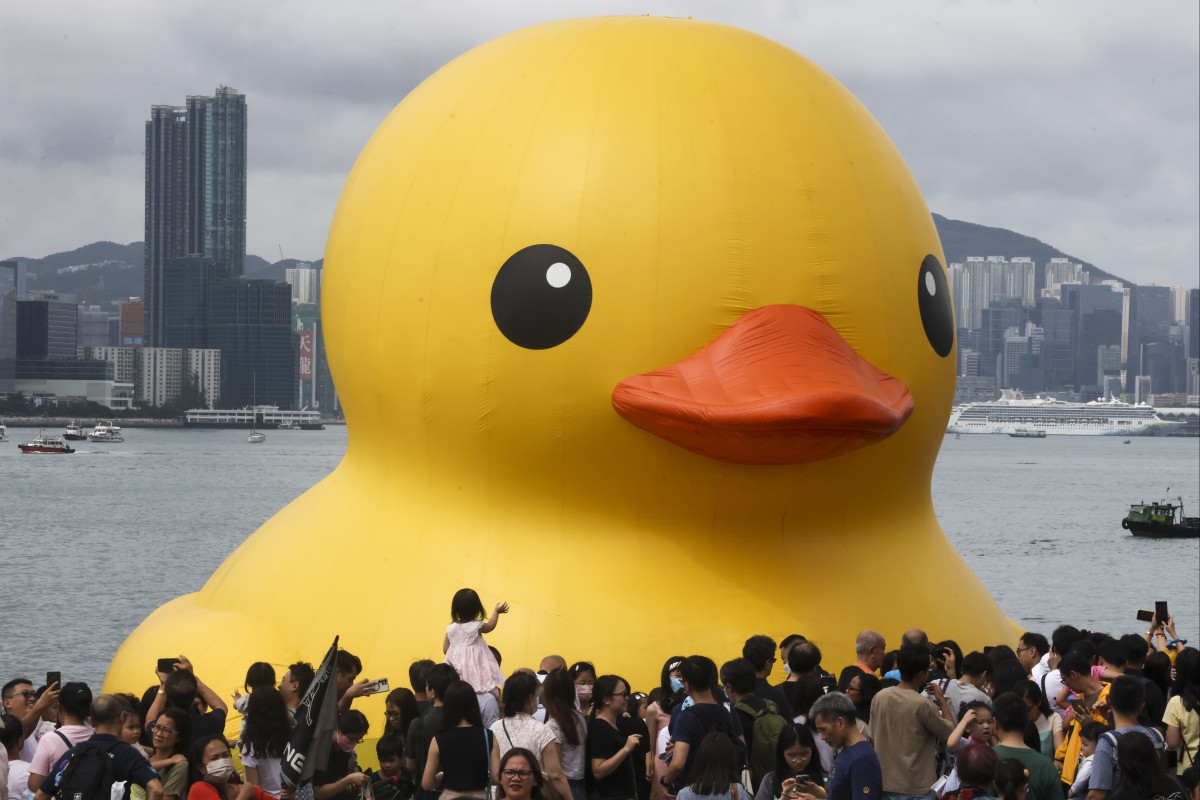
In honour of Hong Kong’s ‘Double Ducks’, the history of rubber ducks and how Sesame Street made them popular
- Although the “Double Ducks’ have left Victoria Harbour, you can keep the ducky love going with these fun facts about our feathery friends
- Local tycoon Lam Leung-tim helped make the toy popular, as well as Ernie’s beloved ‘Rubber Duckie’ song
 People at Tamar Park take photos with the two giant rubber ducks anchored at Victoria Harbour on the last day of “The Double Ducks by Florentijn Hofman”. Photo: Dickson Lee
People at Tamar Park take photos with the two giant rubber ducks anchored at Victoria Harbour on the last day of “The Double Ducks by Florentijn Hofman”. Photo: Dickson LeeQuack, quack! We’re all bummed that the “Double Ducks” left Hong Kong earlier than planned. In case you couldn’t get enough of them, here are some fun facts about rubber ducks to tide you over until they return.
Key moments in duck history
The rubber duck first appeared in the late 1800s when manufacturers started making use of vulcanised rubber. Still, it wasn’t until Georgian-Russian-American sculptor Peter Ganine patented his design in 1949 that the rubber duck became as famous as we know it, selling more than 50 million toys worldwide.
On the other side of the planet, Hong Kong toy tycoon Lam Leung-tim founded Forward Winsome Industries and launched the popular “Lamon Tea” duck, growing his business at a time when the city’s toy industry was at its peak. Years later, renowned Dutch artist Florentijn Hofman created his famous “Rubber Duck” series of floating sculptures, including the Double Ducks that floated through Victoria Harbour.
How did they become so popular?
Although rubber ducks became a bathroom mainstay by the early 1960s, they got their big break in 1970, thanks to the children’s television show Sesame Street.
On the first season of the show, Ernie splashed in the tub while singing “Rubber Duckie”, a tribute to his bath time bestie. The song was well-loved and recorded as a vinyl single, selling over one million copies. The song is still famous even now, and many people associate Ernie not just with his best buddy Bert, but also his famous floaty pal.
10 duck idioms to help you get into the swim of things
Who has the largest rubber duck collection in the world?
Rubber ducks come in a variety of colours and designs, and many people like to collect them. As of 2011, Charlotte Lee of the US had the largest rubber duck collection in the world, with 5,631 different rubber ducks displayed in glass showcases on the four walls of her dedicated duck room.
What can a rubber duck do?
Rubber ducks can help a child’s developmental skills, specifically their muscle strength and coordination, and their bright colours and squeaky noises can sharpen a toddler’s senses.
Rubber ducks are also useful for scientific research. In 1992, a cargo ship spilled around 29,000 bath toys, most of which were rubber ducks, into the northern Pacific Ocean. The ducks spent years at sea and washed up in different corners of the world.
Sensing an opportunity, scientists started tracking the ducks’ movements and locations to learn more about ocean currents. In 2008, researchers at Nasa dropped 90 rubber ducks in the Jakobshavn Glacier in Baffin Bay, near western Greenland, to track the movements of a glacier.
Our favourite ducks from pop culture, from Donald Duck to Hong Kong’s own B.Duck
What’s with the hole on the bottom?
Wondering why your duck has a hole on the bottom? It actually serves a useful purpose; the hole allows your duck to float upright and make its signature squeaking sound.
Why are rubber ducks yellow?
It’s simple: rubber ducks are supposed to look like baby ducks, which are yellow. Their fur will change to brown or white as they grow. Yellow rubber ducks also symbolise youth and childhood happiness, which explains why many people find it comforting to collect them.
